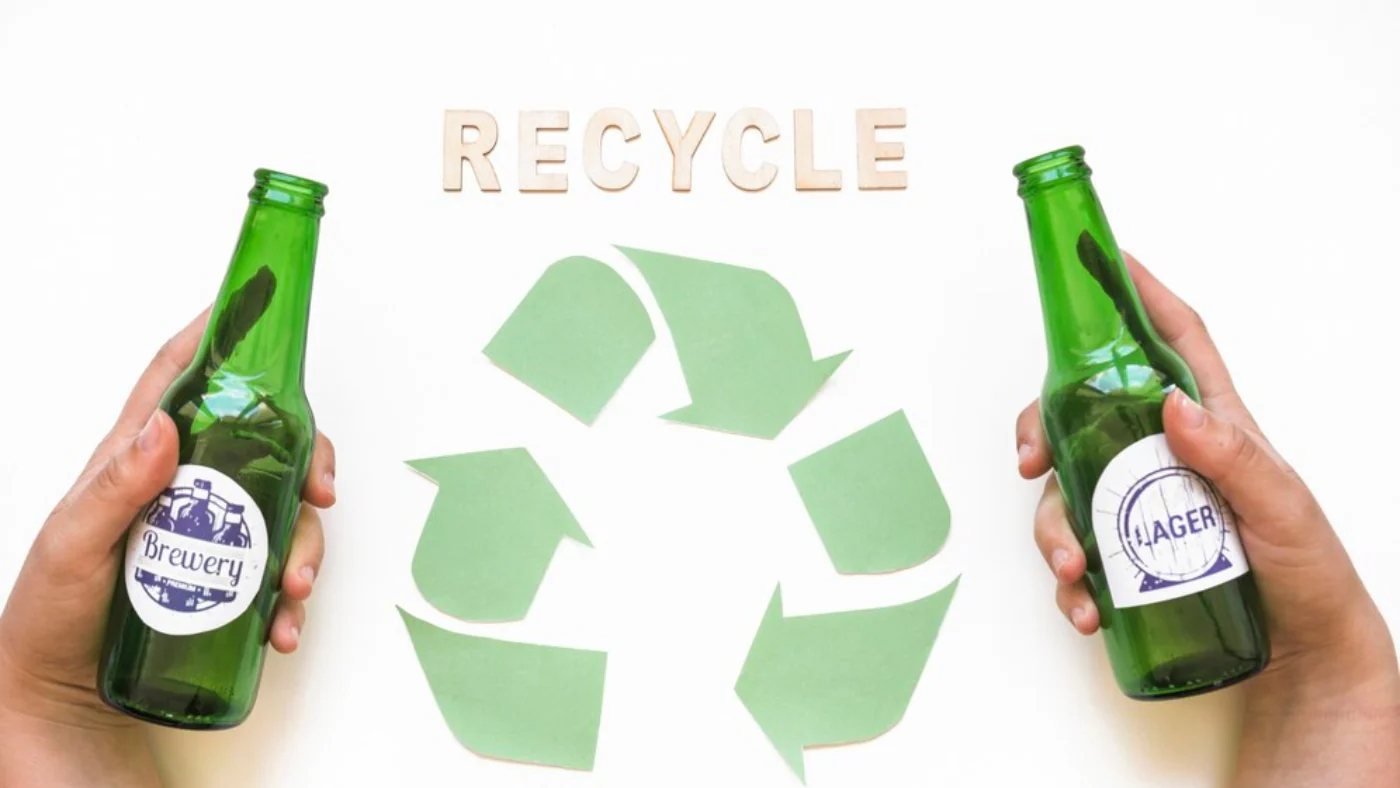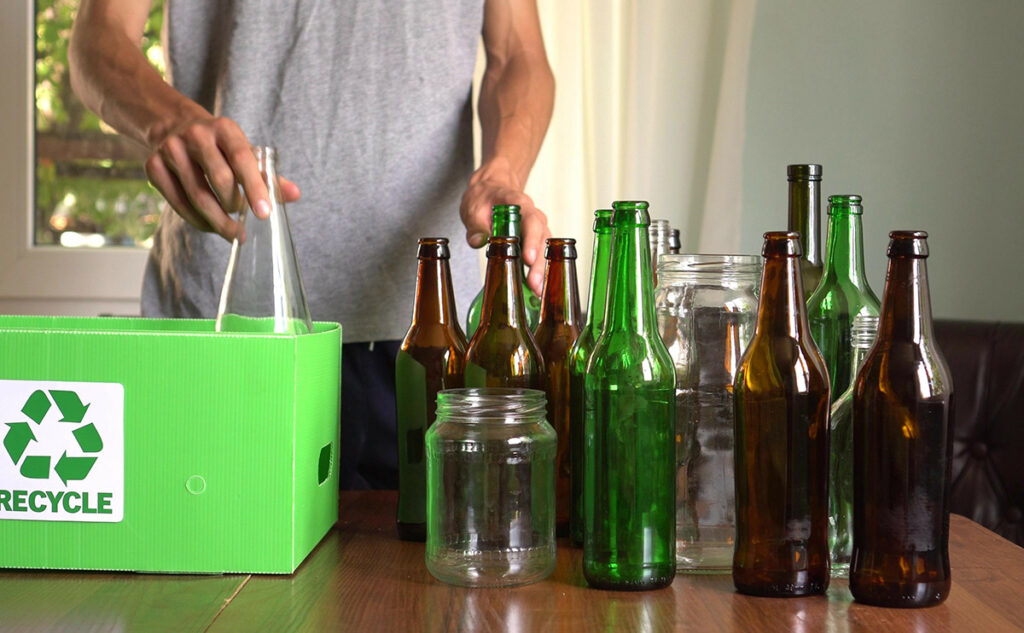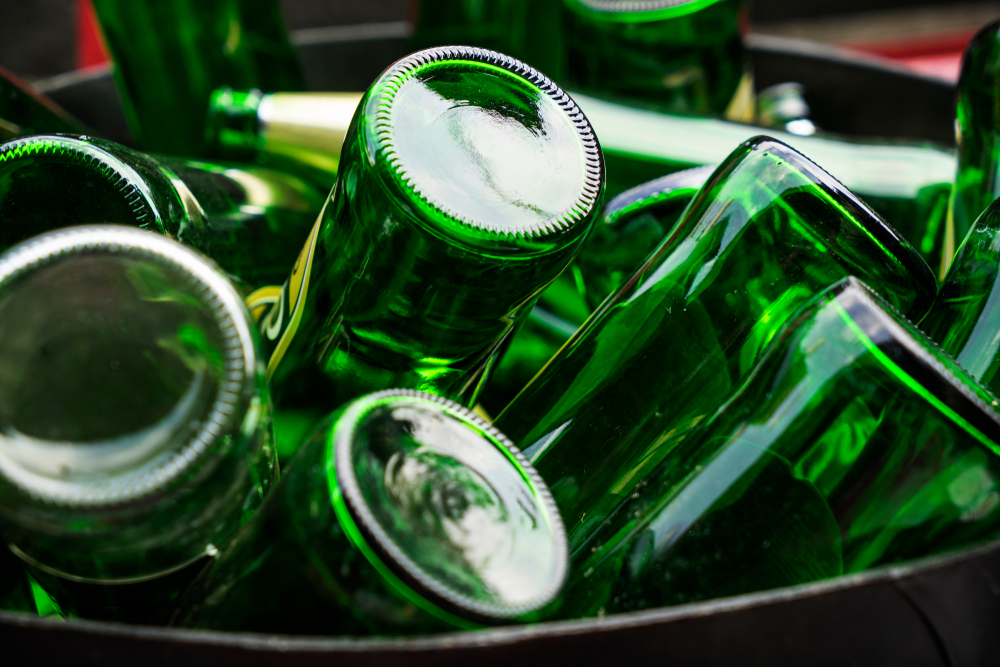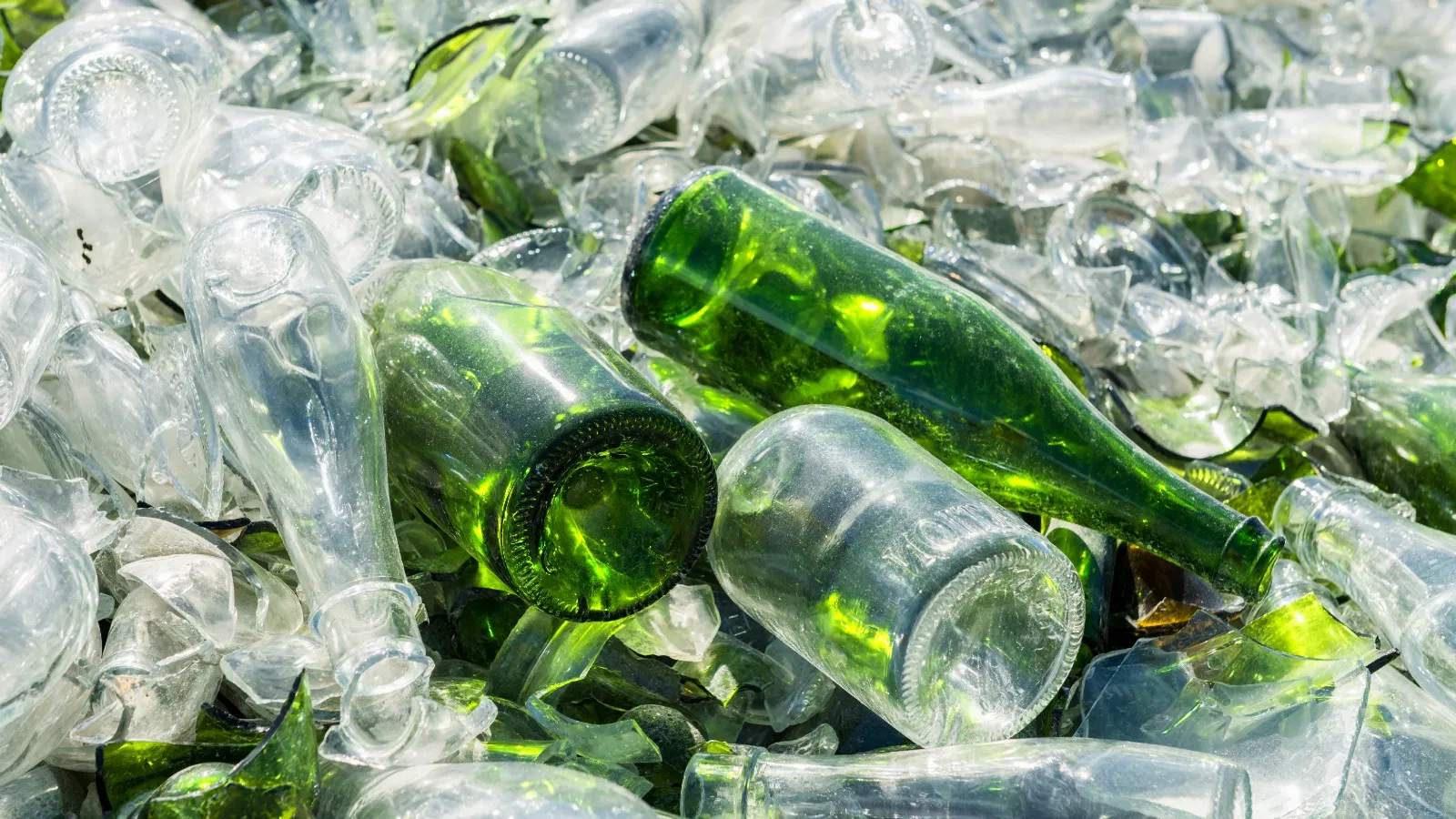Yes, beer bottles are widely recyclable. Across most parts of the United States, recycling them is straightforward. Residents can use curbside pickup bins, visit buy-back centers, or participate in deposit return systems—often referred to as “bottle bills.” These programs help collect and process glass bottles efficiently, preventing them from ending up in landfills.

Table of Contents
Key Facts About Beer Bottle Recycling
Beer bottles are typically made from glass, a material that is 100% recyclable and can be reused endlessly without any decline in quality or purity. It’s worth noting that new glass beer bottles already contain an impressive 96.7% recycled glass on average—far more than most plastic bottles or aluminum cans. Nationally, the recycling rate for glass bottles ranged from 30% to 60% in 2023, placing it above plastic though still behind aluminum. Glass remains a common packaging choice for beer, making up about 26.9% of all U.S. beer packaging in 2023. Certain states show a stronger preference for glass: Maryland led with 35.9% of beer sold in glass bottles, while Arkansas had the lowest share at 20%. Additionally, more than half of imported beers in the U.S. are packaged in glass bottles.
How beer bottle Recycling WorksIn many communities, residents can place clean, empty beer bottles in their curbside recycling bins. Proper sorting is encouraged to avoid contamination and support higher recycling rates. Several states, including Michigan, Oregon, and California, run deposit return systems that refund a small amount when bottles are returned. These programs have proven effective—for example, Connecticut saw recycling rates rise by up to 21% between 2023 and 2024 after system improvements. For those without curbside access, specialized recycling centers offer an alternative. California, for instance, is home to over 1,247 buy-back centers, playing a major role in recycling billions of containers through its program.
Important Recycling Guidelines
Before recycling, it’s best to empty and lightly rinse beer bottles. Metal caps should be removed since they are often made from different materials. Both green and brown glass bottles are recyclable, though it’s a good idea to check if local facilities have specific rules regarding colored glass.
The Impact of RecyclingDespite recycling efforts, a significant number of glass bottles still end up as waste. From 2015 to 2024, Americans discarded roughly 220 billion glass bottles, averaging about 60 bottles per person in 2024. Recycling glass bottles closes the loop—they are turned into new bottles, or used in products like fiberglass insulation and construction aggregates. Companies like TP Glass Bottle emphasize the role of recycled content in manufacturing, helping reduce waste and energy use.
Summary
Beer bottles are highly recyclable and play an important role in sustainable packaging. Through curbside programs, deposit systems, and buy-back centers, consumers can help improve glass recycling rates. States with well-supported return systems tend to see the highest recovery rates. TP Glass Bottle and other industry partners continue to promote the use of recycled glass, supporting both environmental benefits and circular economy goals.
Step-by-Step Beer Bottle Recycling Process
Recycling beer bottles is an effective way to conserve resources and support environmental sustainability. The process consists of several carefully managed stages that transform used bottles into new products. Here’s how it works from beginning to end.
Collection and Transportation
It all starts when people return their used beer bottles to curbside bins, drop-off locations, stores, or recycling centers. These bottles are then transported by trucks to specialized glass recycling facilities.
Sorting by Material and Color
At the recycling plant, the bottles are sorted by color—clear, brown, and green. This step is essential for maintaining the quality of the new glass products. Advanced equipment like scanners and magnets helps remove non-glass items such as metals or plastics.
Cleaning and Label Removal
Next, the bottles go through a deep cleaning process to eliminate leftover liquids, labels, adhesives, and caps. Methods include high-pressure washing, chemical soaking, scrubbing, and rotating screens. Stubborn residues are removed using hot air beds, which also help get rid of sugars and bacteria. A thorough clean is crucial for producing pure recycled glass.
Crushing into Cullet
Once cleaned, the glass bottles are crushed into small pieces known as cullet. Consistency and purity are important here—uniform cullet melts at a lower temperature, which can cut energy use in manufacturing by as much as 30%.
Screening and Further Cleaning
The crushed glass is sifted through mesh screens. Pieces that are too large are crushed again to achieve the desired size. Additional screening helps remove any remaining impurities, resulting in clean, ready-to-melt cullet.
Melting and Reforming
The cullet is melted in industrial furnaces at temperatures around 2,700°F (1,480°C). The molten glass is then formed into new bottles or other products such as construction materials, tiles, or insulation.
Cooling and Quality Inspection
The newly shaped glass items are carefully cooled and undergo strict quality checks. Once approved, they re-enter the supply chain. Many breweries rely on bottles made primarily from recycled glass, effectively closing the recycling loop.
Key Figures and Applications
Recycling glass offers significant energy savings—using cullet can reduce energy consumption by up to 30% compared to raw materials. Proper color sorting remains vital for end-product quality and market acceptance. Besides new bottles, recycled glass is used in fiberglass insulation, construction aggregates, tiles, and abrasives.
Special Cases
In systems with deposit schemes or refillable bottles, containers may be cleaned, sanitized, and reused directly without being crushed—offering an even more resource-efficient path.
Summary of Steps
The beer bottle recycling process includes collection, color sorting, deep cleaning, crushing, sizing, melting, reforming, cooling, and inspection. Each phase helps save raw materials, lower energy use, and keep glass in a continuous closed-loop system. Companies like TP Glass Bottle work within this cycle to promote sustainability and circular economy practices.

How to Prepare Beer Bottles for Recycling
Preparing beer bottles for recycling is a simple yet important process. Doing it correctly helps ensure the materials are efficiently recycled and able to be turned into new products. Here’s a practical guide to get your bottles ready.
Start by removing all caps and lids. Metal caps can usually be recycled along with other metals, while plastic caps often need to go in the trash—though it’s always a good idea to check local guidelines. Keeping materials separate helps prevent contamination and supports smoother recycling operations.
Next, give your bottles a quick rinse. Empty out any leftover liquid and wash away residues. Even small amounts of beer or other substances can affect a whole batch of glass during recycling. A clean bottle leads to better-quality recycled glass and helps avoid attracting pests.
Depending on where you live, you may need to remove labels or foil. While most recycling centers handle labels themselves, some programs—like those in Anoha County—may require you to take off foil covers. Always double-check your local recycling rules to be sure.
It’s best to keep bottles intact. Broken glass is often not accepted curbside, as it poses safety risks and reduces the material’s value. If your local program asks for color sorting, group brown, green, and clear glass separately. This helps produce higher-quality recycled products since mixed colors usually result in lower-grade material.
Only place glass beverage containers in your recycling bin. Other glass items like drinking glasses, ceramics, mirrors, or window panes have different melting properties and can contaminate the entire batch.
Key Facts and Figures
On average, glass bottles and jars in the U.S. contain about 40% recycled content, with some brands using up to 95% recycled glass. When glass is sorted properly, up to 90% of bottles and jars can be turned into new containers. In fact, a glass bottle can go from the recycling bin back to a store shelf in as little as 30 days.
Currently, the U.S. recycles about 34% of its glass bottles—significantly lower than the 67% recycling rate for aluminum cans. Every ton of recycled glass saves over a ton of natural resources, including 1,300 pounds of sand, 410 pounds of soda ash, 380 pounds of limestone, and 160 pounds of feldspar.
Quick Preparation Checklist
To make sure your bottles are recycling-ready: empty and rinse them, recycle metal caps separately, trash plastic caps, remove foil if required, leave labels on unless instructed otherwise, keep bottles unbroken, sort by color if needed, and only include accepted glass types.
By following these steps, you help ensure beer bottles can be transformed efficiently into new bottles, jars, or construction materials. Proper preparation supports higher recycling rates and a more sustainable lifecycle for glass.

Environmental Benefits of Recycling Beer Bottles
Recycling beer bottles brings significant environmental advantages that benefit both local communities and the planet as a whole. By choosing to recycle, we contribute to energy conservation, reduced pollution, and more sustainable use of resources.
Energy Savings and Emissions Reduction
Recycling glass beer bottles saves between 40% and 50% of the energy required to produce new bottles from raw materials. For every metric ton of glass recycled, approximately 42 kilowatt hours of energy and 19 liters of oil are conserved. These energy savings also help reduce greenhouse gas emissions—states with bottle deposit programs, for example, see an annual reduction of $11.3 million in emissions.
Landfill Diversion and Community Health
Recycling one metric ton of glass bottles prevents around 54 cubic feet of waste from entering landfills. This not lessens environmental pollution but also supports public health by reducing trash-related contamination. Furthermore, keeping glass out of the waste stream means less litter in parks, beaches, and rural areas—resulting in cleaner public spaces, fewer flat tires, and safer grazing land for animals.
Reduced Raw Material Use
Using recycled glass reduces the need for raw materials such as sand. This helps minimize mining and quarrying activities, lowers transportation impacts, and preserves natural landscapes. Ultimately, it supports a more sustainable approach to resource consumption by decreasing dependence on non-renewable materials.
Community and Economic Benefits
Effective recycling programs offer notable economic advantages. States and municipalities can save an estimated $10.4 million in reduced litter and waste management costs, along with $9.6 million in public health and environmental expenses. Deposit return systems have proven particularly successful, recovering up to 135,500 tons of glass bottles each year. While some European countries boast glass recycling rates as high as 90%, the U.S. currently recycles about 33% of its glass—equivalent to 3.3 million tons out of 10 million tons produced.
Infinite Recycling and System Efficiency
Like aluminum, glass bottles can be recycled indefinitely without any loss of quality. To maximize efficiency, it’s important to keep glass separate from other recyclables. Mixing materials can lead to sorting issues at recycling facilities, which may prevent glass from being reprocessed.
Summary of Impact
Recycling beer bottles is a simple yet powerful way to cut energy use, reduce emissions, conserve natural resources, and create cleaner, safer communities. States with well-designed recycling and deposit systems clearly demonstrate that these benefits are both measurable and impactful.

Key Numbers and Statistics on Beer Bottle Recycling
Recent data shows that the United States has made measurable progress in beer bottle recycling, though significant challenges remain. Understanding these figures helps paint a clearer picture of where we stand and where improvements are needed.
Beer Bottle Recycling Rates and Packaging Proportions
In 2023, the recycling rate for glass beer bottles in the U.S. reached approximately 39.6%. While this is higher than the rate for plastic bottles, which sits at around 20%, it still trails behind aluminum cans, which are recycled at a rate of 43%. When it comes to packaging choices, glass bottles accounted for 26.9% of all beer packaging that same year. The majority of beer—64.1%—was sold in aluminum cans, with another 8.9% available on draft.
Waste and Consumption Trends
Between 2015 and 2024, Americans disposed of an estimated 220 billion glass beverage bottles, including those used for beer. This averages out to about 60 glass bottles wasted per person in 2024. If current trends continue, the country is projected to discard an additional 878.6 billion beverage containers from 2025 to 2029.
State-by-State Differences in Beer Bottle Use
Significant variations exist from state to state. In 2023, Maryland led the nation with 35.9% of beer sold in glass bottles. On the other end of the spectrum, Arkansas had the lowest share at just 20%. Imported beers showed a strong preference for glass, with over 55% of imported beer brands using glass bottles that year, underscoring its role in the premium segment.
Impact of Deposit Return Systems and Policies
Policy interventions continue to prove highly effective. Connecticut’s improvements to its bottle deposit system contributed to a 21% increase in beverage container redemption between 2023 and 2024. States without structured deposit systems or robust recycling programs often report recycling rates well below 50%, highlighting the importance of supportive policies and infrastructure.
Key Data RecapTo summarize: the U.S. recycled 39.6% of glass beer bottles in 2023, which made up 26.9% of total beer packaging. Over 220 billion glass bottles were wasted between 2015–2024, averaging 60 bottles per person in 2024. Imported beer relied on glass packaging 55% of the time, and while Maryland had the highest share of beer in glass (35.9%), Arkansas had the lowest (20%). Connecticut’s improved deposit system increased redemption rates by 21%.
These numbers indicate meaningful progress has been made, but there is still considerable room for growth. Enhanced policies, expanded deposit systems, and continued investment in recycling infrastructure can significantly reduce the number of glass bottles ending up in landfills.
Conclusion
In summary, beer bottles are not only recyclable but also play a crucial role in building a more sustainable future. Through effective recycling practices, we can significantly reduce waste, conserve natural resources, and lower energy consumption. As a trusted manufacturer dedicated to quality and sustainability, TP Glass Bottle proudly produces glass containers with high recycled content, supporting brands and consumers in achieving their environmental goals. By choosing glass and recycling every bottle, we contribute together to a circular economy—where materials are reused, and nothing is wasted.

